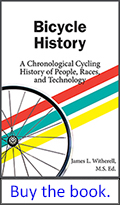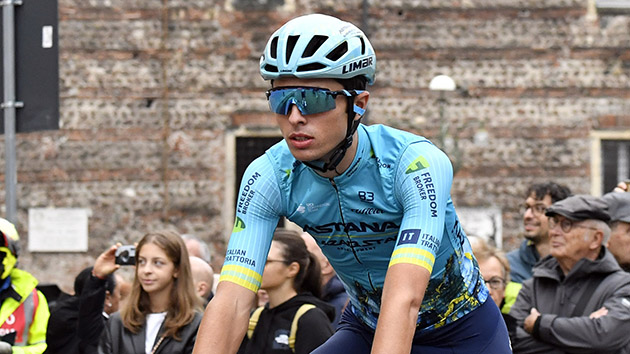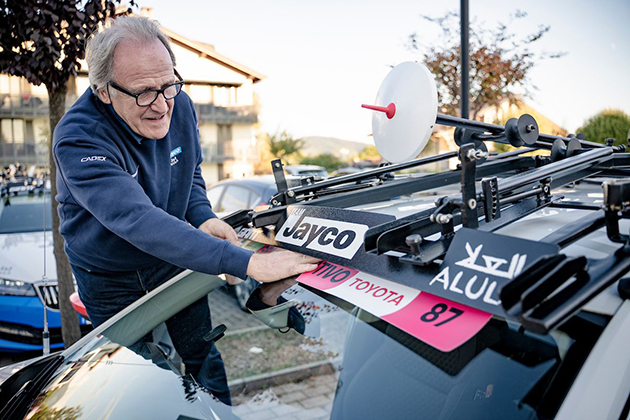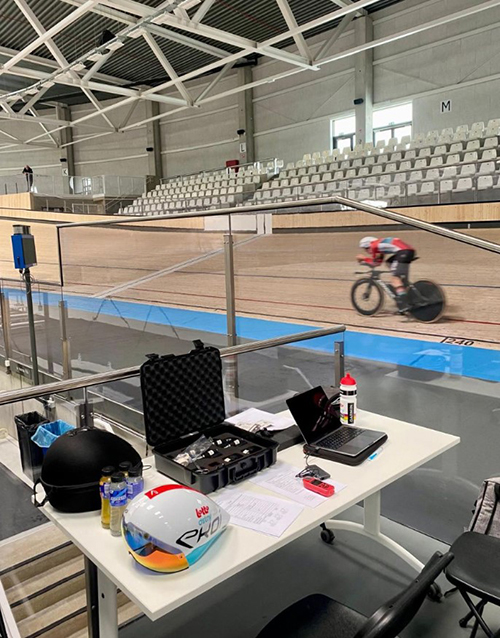

Bicycle Racing News and Opinion,
Sunday, December 8, 2024
Back to news and opinion index page for links to archived stories | Commentary | Our YouTube page
2024 Tour de France | 2024 Giro d'Italia
Every gun that is made, every warship launched, every rocket fired, signifies in the final sense a theft from those who hunger and are not fed, those who are cold and are not clothed. - Dwight D. Eisenhower

James Witherell's book Bicycle History: A Chronological History of People, Races and Technology is available in both print and Kindle eBook formats. To get your copy just click on the Amazon link on the right.
Upcoming racing:
- December 15: Namur Cyclocross-Citadelcross
Latest completed racing:
- November 17: Flandriencross
- November 3: European Cyclocross Championships
- November 1: X20 Trofee Oudenaarde-Koppenbergcross
- October 27: Superprestige Overijse-Vlaamse Druivencross
- October 15 - 20: Tour of Guangxi
- October 20: Japan Cup Road Race
- October 20: Veneto Classic
- October 16: Giro del Veneto
- October 13: Chrono des Nations
Here’s the team’s news:
The 23-year-old Italian rider Davide Toneatti, who has competed with the Astana Qazaqstan Development Team for the past three seasons (2022–2024), is set to make his WorldTour debut with Astana Qazaqstan Team, signing a two-year contract for 2025 and 2026.
“I’m thrilled to sign my first pro contract and step up to the WorldTour with Astana Qazaqstan Team. The trust and support I’ve felt over the past three years in the Development team have been key. I’ve gained valuable experience, and this new challenge motivates me to work harder and achieve my full potential”, – said Davide Toneatti.

Davide Toneatti. Photo: SprintCycling
“Over three years, we’ve seen Davide grow steadily as a rider, showing dedication in training and races. This season, he competed in several races with our WorldTeam without a single withdrawal, delivering a victory and podiums for the Development team. The timing of this move is perfect for his progression, and I’m delighted he’s joining our main team”, – said Alexandr Vinokurov, General Manager of Astana Qazaqstan Team.
Team Jayco Alula posted this:
“The children in my village played soccer in the square. I lived in a farmhouse far away and so I never learned.”
It is the 1950s, Italy is emerging from the destruction of the war, and you have to make do with what you have. Vittorio Algeri, born in 1953, is a lively child and, school aside, his life revolves around the farmhouse of Torre dé Roveri, just outside Bergamo.

Vittorio Algeri
“There were five families, I played, I helped my father in the fields, and on winter evenings all together to recite the rosary in the stable with the animals. It was the warmest place,” he said.
When it comes to the bicycle, it was love at first sight. “At three years old, I could already go without pedals,” Algeri says. “And when I could, I threw myself on the gravel roads. The world of the farmhouse was too small. By pedalling I discovered freedom.”
Alongside him was his older brother Pietro and these early years are ones of adventures, often at the limit. “I was 12 years old, and one Sunday morning the four of us set off to go around Lake Como. It was 250km and we left with nothing to eat and no money. We came back at 8 pm and my father was waiting for us outside the door. I managed to escape, but my brother got a good talking to!”
The two Algeri brothers are not only adventurous, but they are also fast. At 15, Vittorio joins the local team. The jersey is black and blue like that of the Atalanta football team, the steel bike weighs 11 kilos and has five gears. He wins at his first try, arriving alone at the finish line but forgets to raise his arms. It is the beginning of a new life.
From Berlin to Warsaw via Montreal
Algeri becomes an amateur. From spring to autumn, he is a cyclist, and in the winter, he returns to his great love: wood. “I started working as a carpenter when I was 10 years old. It is my great passion; I like to invent and solve technical problems. Wood is an extraordinary material. And then you had to bring money home, in those days it was difficult to make a living from cycling,” he says.
He no longer lives on a farm and his world has become very big. In 1975, the Italian national team called him to participate in the Peace Race, the most important race at the time in the communist bloc.
“I remember that when we crossed the Berlin Wall, the alarm sounded. Police, soldiers started running, I never knew what had happened,” says Algeri.
He still remembers the long lines outside the shops and the obligation to spend all the prize money before going home. “We had won the prologue and then we won other prizes, in kind and in money,” he explains. “They took us around because we had to spend the money. We bought everything, from cameras to crystal vases. Too bad that in Warsaw we realized that shipping everything to Italy would have cost too much. We left half of our things at the airport!”
The 1976 season was a great one. He won the Italian amateur championship and earned a place in the Olympics. He came eighth, with some regrets.
Pro rider and sport director
The doors to professionalism open for Vittorio. He is a fast rider and is not bad on the climbs. His first victory arrives: a stage of the Tour of Belgium. Others will follow in more important races such as stages of the Giro d’Italia and the Tirreno-Adriatico. He also wins on the track and in 1984 he wins the tricolour jersey among professionals, thus achieving a historic double.
In 1987, Algeri decides to get off the bike and get into the team car. “I have always liked teaching young people and when Gianluigi Stanga told me to replace him at the Milan-Turin I didn’t think twice.”
Even as a sports director, Algeri does not lose the habit of winning. From the car he directs some great champions, starting with Gianni Bugno.
“He was not easy to manage, he felt a lot of pressure. For this reason, I had meetings with his teammates but without Gianni. I left him as calm as possible, then at the end of the race he took care of it,” he explains.
After almost 40 years as a sports director, cycling has developed since Algeri made his debut in the team car and the role of a sport director has changed, too. Sometimes it means that the sport directors have less time with the riders than they did in his day. “Cycling has changed a lot,” says Algeri. “When I started in a team there were two directors, and 10-12 riders. Now, there is the risk that a rider meets him at the training camp in December and then nothing until the following year.”
The GreenEDGE Universe
Algeri has been at GreenEDGE Cycling since day one. “I was working in the American team UnitedHealthcare and in the summer of 2011 they called me to introduce me to the new project that was being created by Gerry Ryan. I liked the idea of starting from scratch and I immediately said yes.
“I would not have imagined,” smiles Algeri, “to still be here on the eve of 2025. I have always liked the enthusiasm that the people in the team put into their work. Thanks to everyone we have grown a lot and now there are almost 200 of us.”
In his office at the service course, Algeri deals mainly with organization and logistics. “It never ends. One season ends and the new one begins immediately. I like it, it’s my life.”
In today’s cycling, there are few people who have had such a long and rich career. When asked what his greatest satisfaction was, Algeri distinguishes between when he was a rider and then a sports director.
“As a director, I would say the victory at the Tour of Flanders in 2001 with Gianluca Bortolami. We prepared for it step by step, it was a great adventure.” As a rider Vittorio chooses the Settimana Ciclistica Bergamasca in 1976. “I rode on my own and then I beat the Eastern European champions, who at the time, were professionals who raced with us amateurs.”
The biggest disappointment was the Montreal Olympics. “I chose not to join the breakaway,” Algeri smiles bitterly, “because I was sure that the Russians and Polish would close the gap but it wasn’t like that. So, I started alone, I came back to the leaders with 15 kilometres to go. I tried to attack in the rain, but my legs were very hard. They caught me and I only came in eighth. I still think about It now.”
Here’s the team’s post:
For anyone who thought our riders were still nestled in their winter slumber: think again. While many have headed to the Spanish sun, there’s plenty of activity taking place on the Zolder track. It’s there that our time trial specialists are undergoing intensive testing. Performance coach Oliver Delaey explains how it all works.
Why do our riders use one helmet in race X and a different one in race Y? Which overshoes are the fastest? How does a time trial helmet sit as aerodynamically as possible on the head? And what’s the perfect position for time trial success for a certain rider? These are the kinds of questions that have been answered as accurately as possible over the past few weeks at Zolder, where a select group of Lotto Dstny riders, under the watchful eye of our performance team, aerodynamics specialists, and engineers, underwent a series of tests.

Testing on the Zolder track. Photo: Brecht Steenhouwer
Oliver Delaey, performance coach at Lotto Dstny, explains how such tests are conducted:
“Essentially, a rider arrives on a test day as if he were preparing for a race. He brings his bike and wears the gear he would use during competition. We try to replicate the race setup as closely as possible. We also record environmental parameters such as temperature, humidity, air density, and air pressure.”
To standardize the tests, the team developed an algorithm that produces a so-called CdA value. CdA expresses the drag area of an object by combining the drag coefficient (Cd) with the frontal area (A), essentially measuring its aerodynamics. “To calculate the CdA value, we record speed and power during a test run and plug them into the formula,” Delaey explains. “The rider gets on the bike after being weighed—along with the bike—this is taking into account along with relevant environmental factors. He then completes his baseline test run of six to eight laps at three different speeds. For instance, he starts with six laps at 40 km/h, followed by a recovery lap before building up to seven laps at 45 km/h, and finally, eight laps at 50 km/h. The test doesn’t need to last longer because fatigue would increase the margin of error. Afterward, we process all data to calculate a CdA value for each speed of the baseline test run. After that, we apply a modification regarding his position (e.g. handlebar width, -height…) or material (e.g. cockpit, bidon, clothing, helmet…) and we start a subsequent test run. We repeat this procedure to approximately six test runs per session, the test doesn't need to last longer because fatigue would increase the margin of error. Comparing the different test runs allows us to compare different positions and/or equipment at three distinct speeds and helps us to find the optimal setup."
The track tests provide a wealth of information, primarily for our time trial specialists who aim to be as aerodynamic as possible on their bikes for their first time trials of the season. But the insights also benefit the rest of the team. “We also conduct general tests, which we process into a database to create guidelines for the entire team. This way, even those who haven’t undergone individual testing can benefit from our work. For example, when it comes to helmets, we might know that helmet X performs best in race Y. Even if that helmet is 200 grams heavier, it might still be more aerodynamic and outweigh the heavier weight in a certain race. This process allows us to build a comprehensive database for all our equipment.”
Back to news and opinion index page for links to archived stories | Commentary







